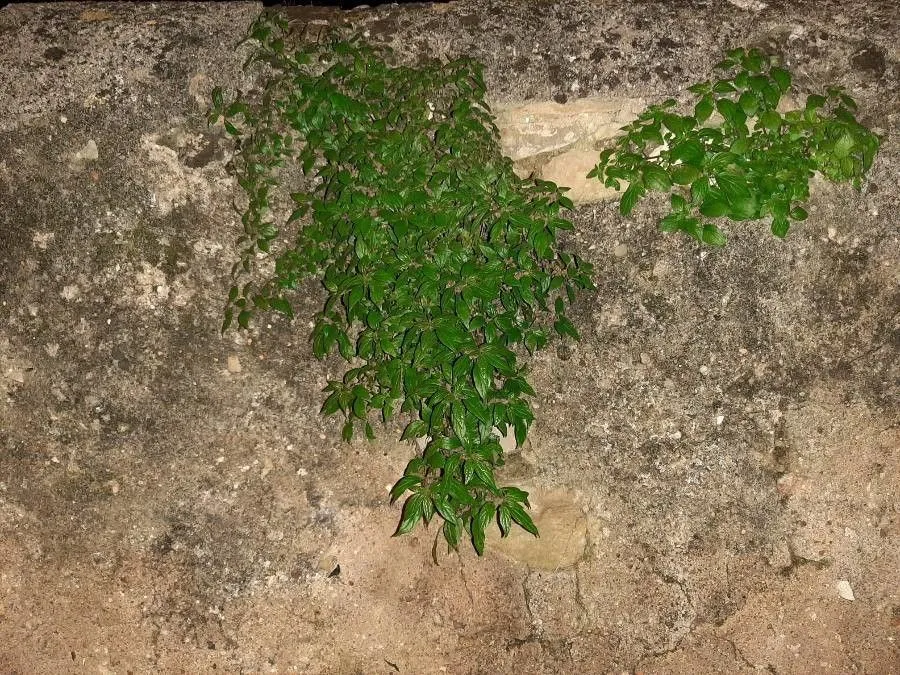
Author: L.
Bibliography: Sp. Pl.: 1052 (1753)
Year: 1753
Status: accepted
Rank: species
Genus: Parietaria
Vegetable: False
Observations: EC. & S. Europe to N. Iran and Turkmenistan
Pellitory-of-the-wall, scientifically known as Parietaria officinalis, is a perennial herb belonging to the Urticaceae family. This resilient plant has a broad natural range, extending from the ecological corners of Southern and Eastern Europe to regions in Northern Iran and Turkmenistan.
Characteristically, Pellitory-of-the-wall is identifiable by its slender, upright stems which can grow up to 70 centimeters tall. The leaves are simple, oblong to lanceolate, and alternately arranged along the stem. Tiny greenish flowers appear in the leaf axils, typically between late spring and early fall, often going unnoticed given their minute size. These blossoms give way to small achenes, the plant’s means of propagation.
This herb is famed for its adaptability, often thriving in nooks and crevices of walls, hence deriving its common name. It cherishes environments that are shaded and have ample moisture but can also endure drier conditions.
In historical texts, Parietaria officinalis was first meticulously documented by the eminent botanical author L. in “Species Plantarum” (Sp. Pl.: 1052) in the year 1753. Since then, it has captivated the attention of botanists and herbalists alike for both its distinctive growth habits and reputed medicinal properties. Traditionally, this plant has been utilized in folk remedies, credited with diuretic, anti-inflammatory, and expectorant benefits.
Despite its often inconspicuous presence, Pellitory-of-the-wall plays an important ecological role. It serves as a larval food plant for certain butterfly species, thereby contributing to biodiversity and the ecological balance of its native habitats.
In summary, Parietaria officinalis is not just a botanical curiosity growing on vertical surfaces but a significant plant with a rich history and multitude of uses in herbal medicine. Its ability to quietly embed itself into various landscapes while providing ecological benefits makes it a remarkable subject of study for both botanists and nature enthusiasts.
Dan: almindelig springknap, springknap
Deu: aufrechtes glaskraut, gemeines glaskraut
Eng: eastern pellitory-of-the-wall, upright pellitory, erect pellitory-of-the-wall, pellitory-of-the-wall, wall pellitory, white pellitory
Ces: drnavec lékařský
Nld: groot glaskruid
Fra: pariétaire officinale
Swe: väggört, blidnässla, vanlig väggört
Nob: legeblidnesle
Nno: legeblidnesle
Cym: paladr-y-wal dwyreiniol
Tur: yapiskan otu
Kat: კედლისპირა
En: Pellitory-of-the-wall, Wall pellitory, Eastern pellitory-of-the-wall, Upright pellitory, Erect pellitory-of-the-wall, Lichwort, White pellitory
Ar: حشيشة الزجاج المخزنية
Az: Dərman qayaotu
Eu: Horma-belar sendagarri
Bg: Лечебна разваленка
Ca: Morella roquera, Came-roja, Caragolera
Co: Vitriolu
Hr: Ljekovita crkvina
Cs: Drnavec lékařský
Da: Almindelig Springknap, Springknap
Nl: Groot glaskruid
Et: Harilik juudinõges
Fi: Pystymuuriyrtti
Fr: Pariétaire officinale, Casse-pierre, Herbe à bouteille, Perce-muraille
Ka: Კედლისპირა
De: Aufrechtes Glaskraut, Gemeines Glaskraut
Hu: Falgyom
Io: Parietario
Ga: Feabhraíd reatha
It: Vetriola comune
Nb: Legeblidnesle
Nn: Legeblidnesle
Fa: پاریتاریا آفیسینالیس
Pt: Alfavaca-de-cobra, Cobrinha, Erva-das-muralhas, Erva-das-paredes(1), Erva-de-nossa-senhora, Erva-de-sant’ana, Erva-dos-muros, Erva-fura-paredes, Fura-parede, Helxina, Parietaria, Pulitaina, Pulitária, Quebra-pedra (3)erva-de-santa-ana
Sv: Väggört, Blidnässla, Vanlig väggört
Tr: Duvar fesleğeni, Yapışkan otu, Yapiskan otu
Cy: Paladr-y-wal dwyreiniol
Taken May 23, 2021 by Sabin Poenariu (cc-by-sa)
Taken Jan 11, 2022 by Monteiro Henrique (cc-by-sa)
Taken Jun 1, 2020 by Maria Taria (cc-by-sa)
Taken Mar 26, 2020 by j B (cc-by-sa)
Taken Jan 15, 2021 by Monteiro Henrique (cc-by-sa)
Taken Jan 15, 2021 by Monteiro Henrique (cc-by-sa)
Taken Jan 15, 2021 by Monteiro Henrique (cc-by-sa)
Taken Dec 17, 2021 by Dominik Zentgraf (cc-by-sa)
Taken Nov 30, 2022 by Michel AMBROISE (cc-by-sa)
Taken Oct 26, 2017 by jose (cc-by-sa)
Taken Jun 9, 2022 by Julijana (cc-by-sa)
Taken Jun 13, 2021 by Manū (cc-by-sa)
Taken Nov 30, 2022 by Michel AMBROISE (cc-by-sa)
Taken Jun 14, 2021 by Dominique Vioux (cc-by-sa)
Taken Mar 30, 2019 by Ricardo Lemaur (cc-by-sa)
Taken Nov 11, 2016 by Tela Botanica − Liliane ROUBAUDI (cc-by-sa)
Taken Sep 10, 2021 by YUSUF AHMED (cc-by-sa)
Taken May 8, 2017 by Yoan MARTIN (cc-by-sa)
Taken Nov 30, 2021 by Raffaella D’Ambra (cc-by-sa)
Taken May 8, 2017 by Yoan MARTIN (cc-by-sa)
Taken Jan 1, 1800 by Tela Botanica − Thierry Pernot (cc-by-sa)
Taken Jan 1, 1800 by Tela Botanica − Thierry Pernot (cc-by-sa)
Taken Jan 1, 1800 by Tela Botanica − Thierry Pernot (cc-by-sa)
Taken Apr 26, 2015 by Tela Botanica − Yves PENIT (cc-by-sa)
Taken May 10, 2020 by maire sofia (cc-by-sa)
Taken Nov 11, 2016 by Tela Botanica − Liliane ROUBAUDI (cc-by-sa)
Taken Nov 11, 2016 by Tela Botanica − Liliane ROUBAUDI (cc-by-sa)
Taken Nov 11, 2016 by Tela Botanica − Liliane ROUBAUDI (cc-by-sa)
Taken May 8, 2017 by Yoan MARTIN (cc-by-sa)
Taken Jul 9, 2022 by Benoît Janichon (cc-by-sa)
© copyright of the Board of Trustees of the Royal Botanic Gardens, Kew.
© copyright of the Board of Trustees of the Royal Botanic Gardens, Kew.
© copyright of the Board of Trustees of the Royal Botanic Gardens, Kew.
Growth habit: Forb/herb
Ph maximum: 7.5
Ph minimum: 7.0
Light: 6
Atmospheric humidity: 5
Bloom months: [‘jun’, ‘jul’, ‘aug’, ‘sep’, ‘oct’]
Soil nutriments: 7
Family: Myrtaceae Author: (F.Muell.) K.D.Hill & L.A.S.Johnson Bibliography: Telopea 6: 402 (1995) Year: 1995 Status:…
Family: Rubiaceae Author: Pierre ex A.Froehner Bibliography: Notizbl. Bot. Gart. Berlin-Dahlem 1: 237 (1897) Year:…
Family: Sapindaceae Author: Koidz. Bibliography: J. Coll. Sci. Imp. Univ. Tokyo 32(1): 38 (1911) Year:…
Family: Asteraceae Author: A.Gray Bibliography: Pacif. Railr. Rep.: 107 (1857) Year: 1857 Status: accepted Rank:…
Family: Fabaceae Author: Medik. Bibliography: Vorles. Churpfälz. Phys.-Ökon. Ges. 2: 398 (1787) Year: 1787 Status:…
Family: Aspleniaceae Author: (Cav.) Alston Bibliography: Bull. Misc. Inform. Kew 1932: 309 (1932) Year: 1932…